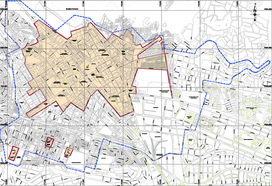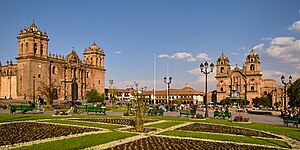
Back Plaza de Armas del Cuzco Spanish Cuscoko Arma Plaza Basque Waqaypata Quechua Пласа-де-Армас (Куско) Russian 兵器广场 (库斯科) Chinese
| Plaza Mayor del Cusco | |
|---|---|
| Huacaypata | |
 National Cultural Heritage and World Heritage Site | |
 Location map | |
| Type | Public square |
| Location | |
| Coordinates | 13°31′00″S 71°58′44″W / 13.516711°S 71.978822°W |
| Area | 28728 square meters |
| Created | 11th century |
| Founder | Legendary establishment of the city by Manco Capac |
| Status | Open |
| Other information | Adjacent roads, from the Cathedral in a clockwise direction:
Calle Triunfo Calle Santa Catalina Angosta Calle Loreto Calle Mantas Calle del Medio Calle Espaderos Calle Plateros Calle Procuradores Calle Suecia Calle Cuesta del Almirante |
 Plaza Mayor del Cusco at present time | |
 | |
| Location | |
|---|---|
| Type | Main Square |
| |
The Plaza de Armas of Cusco is located in the city of Cusco, Peru. Located in the historic center of the city is the main public space of the town since before its Spanish foundation in 1534.
Geological studies carried out in the area show that it originally had a swamp,[1] crossed by the Saphy River (currently channeled and covered). During the Inca Empire, this swamp was dried up and transformed into the administrative, religious and cultural center of the imperial capital.[2] It was the place where all kinds of ceremonies were held and the victories of the Inca army were celebrated. After the Spanish conquest, it was transformed into a plaza (square) by the new rulers, who built Catholic temples and mansions on the ruins of the ancient Inca palaces. In this square, Túpac Amaru II was executed in 1781 as well as the cacique Bernardo Tambohuacso, Mateo Pumacahua and several other heroes of the independence of Peru.
Today it is the central core of modern Cusco, surrounded by tourist restaurants, jewelry stores, travel agencies and the same Catholic churches built during the colonial period and which constitute two of the most important monuments of the city: the Cathedral of Cusco and the Iglesia de la Compañía de Jesús (Church of the Society of Jesus).
Since 1972, the building has been part of the Monumental Zone of Cusco, declared a Historic Monument of Peru.[3] Likewise, in 1983, as part of the historic center of the city of Cusco, it became part of the central zone declared by UNESCO as a World Cultural Heritage Site.[4]
- ^ Angles Vargas (1998, p. 74)
- ^ Angles Vargas (1998, p. 77)
- ^ Relación de monumentos históricos del Perú (PDF) (in Spanish). Lima: Instituto Nacional de Cultura. 1999. p. 37. Retrieved 19 August 2019.
- ^ "Ciudad del Cusco" (in Spanish). UNESCO. 19 August 2019.
© MMXXIII Rich X Search. We shall prevail. All rights reserved. Rich X Search